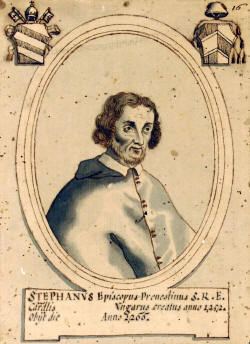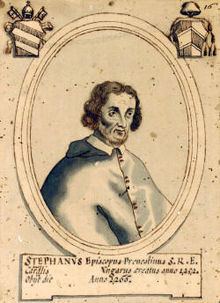Province Esztergom Term ended 1252 See Esztergom Predecessor Matthias Ratot | Appointed 14 August 1242 Name Stephen Bancsa Installed 7 July 1243 | |
 | ||
Stephen (I) Báncsa (Hungarian: Báncsa or Váncsa (I) István; died July 9, 1270) was the first Hungarian cardinal of the Roman Catholic Church.
Contents
Early life
He was a descendant of the original settler family, Bács. In 1236 he was Provost of Bács and Chancellor of King Béla IV between 1238 and 1240. In 1241 he was appointed Bishop of Vác by King Béla. He was elected by the Cathedral Chapter as Archbishop of Esztergom in 1243, being transferred from the Diocese of Vác with the permission of Pope Innocent IV, granted on July 7, 1243. On July 19, 1243, Pope Innocent wrote to the new Archbishop, appointing him Apostolic Legate in Croatia and Dalmatia. He served as Archbishop until he was appointed Cardinal Bishop of Praeneste (Palestrina). Even so, he continued to serve as Administrator of the Diocese of Esztergom (Strigonia) (1252–1254), until a successor, Archbishop Benedict, was appointed on February 25, 1254. He was advised, however, that during his Administratorship, he should not give away pensions or prebends without the express permission of the Holy See.

Báncsa was made cardinal in December 1251 by Pope Innocent IV, and appointed the Cardinal-Bishop of Palestrina. This was at a time when the church was having problems with the Tatars.
In 1253, he became ill, due to his being unaccustomed to the climate, among other reasons, and he therefore petitioned Pope Innocent IV to allow him to return to Hungary. Innocent and the cardinals were reluctant to lose him and his expertise, but Innocent granted him the privilege of returning to Esztergom, and continuing his administration of that diocese, until the next Feast of All Saints (November 1). At that point he was to resign the Church of Esztergom to a prelate of the Kingdom of Hungary of his choice, and return to the Papal Curia by Christmas, 1253. If he did not return by that date, the bishopric of Palestrina was to be considered vacant. He returned, of course.
Role in the Roman Curia
Báncsa was present in the Roman Curia at Anagni and subscribed papal documents under Innocent IV, on February 25, 1253; April 13, 1253; May 31, 1253; May 28, 1254; July 4, 1254; and July 22, 1254. When Innocent IV moved south with the papal army to confront Manfred, the Sicilian Regent, he accompanied the Pope, leaving Anagni on October 8, arriving at Montecassino on October 13 for a three-day rest, and finally reaching Naples on October 27. The Pope died in Naples on December 7, five days after the disastrous battle of Foggia in which the papal army was soundly defeated and lost over 4,000 men. Cardinal Stephanus participated in the very short papal election of December 11–12, 1254 (that elected Raynaldus de' Conti as Alexander IV). He subscribed regularly throughout the reign of Alexander IV as a member of the Pope's closest group of advisors. The Curia remained at Naples until the first week of June, 1255, and then returned to Anagni. They did not take up residence in Rome until mid-November, there to remain until June 1, 1256, when the Curia returned to Anagni. During his time in Naples, Cardinal Stephen served as papal Auditor in the case of Bishop Ponce of Urgel; on December 15, 1254, he confirmed the sentence against Ponce for simony, incest, and other charges, and suspended Ponce; the sentence was confirmed by Alexander IV on January 7, 1255.
On July 3, 1260, at Anagni, he and seven other cardinals signed a Decree for Alexander IV, regulating the Greek and Latin dioceses on the island of Cyprus. On April 1, 1261, Cardinal Báncsa, along with Cardinals Odo of Chateauroux, John of Toledo, Hughes de Saint-Cher, and Ottobono Fieschi, signed a constitution of Alexander IV in favor of the convent of Val-de-Grace in the diocese of Konstanz. The document was signed at the Lateran Palace in Rome.
Báncsa did not attend the papal election of May 26 - August 29, 1261 (Urban IV), according to Salvador Miranda. He was present, however, according to Wilhelm Sievert. On January 23, 1262, at Viterbo, less than five months after the Election, Cardinal Stephanus participated with eleven other cardinals in signing a Bull to the benefit of the Teutonic Knights. The evidence, tentative as it is, tends to favor Sievert.
Cardinal Báncsa was present for the Election of October 1264 - February 5, 1265 (that elected Clement IV). On February 26, at Perugia, only three weeks after the Election and three days after the Coronation, he and fifteen other cardinals subscribed a bull, Olim regno, notifying Henry of England and his son Edmund that they were not the true possessors of the Kingdom of Sicily.
Báncsa was working in Viterbo in the Curia in 1268. On March 28, 1268, he is attested as having judged a case in favor of the Lateran Basilica.
The Cardinal also participated in the Election of November 1268 - September 1, 1271, the longest papal election in history, during which he died, purportedly on July 9, 1270. In the Spring of 1270, Cardinal Báncsa, Cardinal Ottobono Fieschi, and other prelates wrote to the General Chapter of the Order of Preachers, which was meeting in Milan, thanking them for their services to the Church.
His nephew Orbász Báncsa was the first Hungarian to obtain a doctorate from the University of Padua (1264). His other nephew was Stephen II Báncsa, the Archbishop of Kalocsa from 1267 to 1278.
Date of death
The date of death is according to the sources consulted (as cited by Salvador Miranda), except J. P. Adams Sede Vacante 1268-71, who quotes a document from the Vatican Archives that shows that Cardinal Stephen subscribed a letter dated August 22, 1270, and therefore could not have died on July 9.
